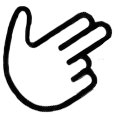A common challenge among new cuers is deciding which handshape to use for words containing the digraph "th." In English, there are several different building blocks (phonemes) that can be represented by the letters "th."
 Voiceless "th" or /θththθththθthth/ - Handshape 7
Voiceless "th" or /θththθththθthth/ - Handshape 7
The voiceless "th" is found in words like thief, throw, and both. In the International Phonetic Alphabet (IPA), it is represented by the theta: θ. In a basic phoneic representation, it is sometimes simply represented by lowercase th. The book Gaining Cued Speech Proficiency by Walter J. Beaupre uses the letters xh to represent this phoneme. In speech production, it is made as a voiceless interdental fricative – meaning that the tongue is placed between the teeth, the vocal cords do not vibrate, and that it is a noisy, turbulent sound made by a narrow constriction in the mouth. When cueing, it is produced with handshape 7 – only the index, middle finger, and thumb are extended.
1-Syllable Words
bath, both, cloth, death, eighth, fifth, fourth, ninth, north, Seth, sloth, south, teeth, tenth, thank, theme, thigh, think, thing, third, thick, thin, thought, thread, threw, thrill, through, throw, thumb, threat, thrust, truth
2-Syllable Words
anthem, athlete, author, bathtub, Catholic, faithful, hundredth, nothing, python, something, thankful, thirty, thunder, threatening, thrilling, Thursday, toothbrush
3-Syllable Words
Athena, Anthony, catheter, Cynthia, synthetic, theatre, thematic, therapy
4-Syllable Words
authority, forsythia, thermometer
5-Syllable Words
anthropology, apothecary, photosynthesis
 Voiced "th" or /ðt͟htHðt͟htHðt͟htH/ - Handshape 2
Voiced "th" or /ðt͟htHðt͟htHðt͟htH/ - Handshape 2
The voiced "th" is found in words like those, brother, and worthy. In the International Phonetic Alphabet (IPA) it is represented by the letter eth (pronounced /ɛěehɛěehɛěehðt͟htHðt͟htHðt͟htH/): ð. It is also sometimes represented by tH (lowercase t and uppercase H), th (italicized th), th (underlined th) and TH (uppercase t and h), as well as combinations of those variations. In speech production, it is considered a voiced interdental fricative. It is produced nearly identically to the /θththθththθthth/ above, except with the addition of vocal cord vibration. When cueing, this phoneme is represented with handshape 2. Only the index finger and thumb are fully extended.
1-Syllable Words
smooth, soothe, than, that, the, them, there, these, they, this, those, though, writhe
2-Syllable Words
bother, clothing, breathing, either, farther, father, feather, further, leather, gather, northern, rhythm, weather
3-Syllable Words
Other Phonemes
The letters "th" can represent other phonemes as well. They can less commonly (but more accurately) stand for the phonemes /t/ and /h/ as in boathouse. They can also simply represent the phoneme /ttttttttt/ as in Thai, Thomas, thyme.
Instruction
When providing examples to aid students with discrimination, it can be useful to give examples that only differ in the way you wish to highlight. However, there are not many words that differ solely in /θththθththθthth/ and /ðt͟htHðt͟htHðt͟htH/. A few examples are provided below:
|
|
| sooth (as in a sooth sayer) | soothe (as in to comfort) |
| ether (chemical compound) | either (as in either/or) |
Hearing Students
While hearing, native English speakers generally do not confuse the different pronunciations of "th" while speaking, they do have difficulty consciously perceiving which they are targetting in order to assign a handshape. So while they can say the right sound, they may not be sure which they are saying in a given word. These students are encouraged to feel their vocal cords and assess the "breathiness" of their production to help them decide which handshape to use. It is essential that students be reminded not to whisper while trying to feel for vocal cord vibration as whispering is the act of speaking without using the vocal cords.
Deaf Students and English Language Learners
The linguistic background of students is essential. Many traditional techniques for teaching "th" words rely on the fact that students produce the targets correctly in speech but need to assess what they say in order to cue properly. However, students who have had limited, incomplete, or inaccurate exposure to English may not have an internalized target to assess. In other words, students who learned English as a second language may not know which "th" sounds to produce while speaking. So, they aim for the wrong target because a different pronunciation is in their mind. These students will frequently ask for a pattern to know which words use which "th". Unfortunately, phonemes are arbitrary and follow no such pattern. Some rules of thumb can be given, but students must be cautioned that exceptions will be common:
- "th" words for family members generally use handshape 2: mother, father, brother.
- "th pronouns generally use handshape 2: they, them, this, that, these, those.
- Some "th" noun-verb pairs change from handshape 7 to handshape 2: teeth-teethe, breath-breathe, bath-bathe, cloth-clothe (Note: some vowels also change between the pairs)
Links
- Which "th" is it? The Games and Quizzes section of DailyCues.com offers this interactive exercise. Ten words are randomly selected from a bank of words. You must decide if the "th" would be cued with handshape 2 (these), handshape 7 (thief), or neither one (Thai). Your answers are checked and you get a percentage of your right answers.
- Think About This - A free online course/practice session with video lessons and activities from Language Matters Academy.